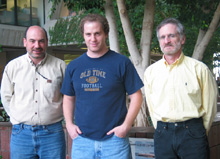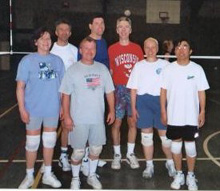
|
Monday, October 18
2:30 p.m. Particle Astrophysics Seminar - Curia II
Speaker: M. Perelstein, Cornell University
Title: Two Topics in Cosmoparticle Physics
3:30 p.m. DIRECTOR'S COFFEE BREAK - 2nd Flr X-Over
THERE WILL BE NO ALL EXPERIMENTERS' MEETING THIS WEEK
Tuesday, October 19
3:30 p.m. DIRECTOR'S COFFEE BREAK - 2nd Flr X-Over
THERE WILL BE NO ACCELERATOR PHYSICS AND TECHNOLOGY
SEMINAR TODAY
|

Monday, October 18
Minestrone
Chicken & Mushroom Cheese Steak $4.75
Baked Chicken Enchiladas $3.75
Carved Roast Beef $4.00
Smoked Turkey Panini Pesto Mayo $4.75
Western Ranch Bagel $2.75
Pacific Rim Rice Bowl $4.75
Wilson Hall Cafe Menu
Chez Leon
|




|
 |
Juan Estrada Receives Award at Rome Meeting
|

|
|
(Left to Right) Paul Rubinov, Juan Estrada and Alan Bross
collaborated together on the VLPC.
Carlos Garcia from University of Rochester and Bruce Hoeneisen
from Universidad San Francisco de Quito in Ecuador also contributed to the
project. (Click on image for larger version.) |
|
|
Juan Estrada of DZero received an award in Rome today at the meeting of the
Institute of Electrical and Electronics Engineers-Nuclear and Plasma Sciences
Society. The Radiation Instrumentation Early Career Award is given
once every two years "in recognition of significant and innovative technical
contributions" to the science of measuring ionizing radiation.
PPD's Marvin Johnson nominated Estrada for a project he led last year on DZero's
Visible Light Photon Counter. Alan Bross and Paul Rubinov of Fermilab,
Carlos Garcia of the University of Rochester, and Bruce Hoeneisen from the
Universidad San Francisco de Quito in Ecuador contributed to the work.
As the Tevatron dramatically increased luminosity last year, physicists expected
the operating, "bias" current in the VLPC to increase as a side-effect. Instead,
they observed a 10 percent drop. Estrada and his collaborators developed a
theoretical model to interpret this behavior, and their computer simulation
showed their guess was correct: It's the very avalanches of electrons the
VLPC is meant to detect - those that signal the passage of photons - that
caused the current to drop.
"The current decreases because the avalanches start occupying a significant
area of the tracker," Estrada said. During an avalanche, a small, but not
negligible region of the VLPC becomes unable to conduct electricity for a
few milliseconds. "It's like producing a hole in the VLPC."
Knowing the VLPC's response to luminosity increases is important to correctly
interpret the data coming out of DZero, Estrada said.
Estrada is a Wilson fellow and has won the 2003 Alvin Tollestrup award for
his analysis work on measuring the mass of the top quark.
|
Playing Havoc Getting Ready to Defend Championship
|

|
|
The Playing Havoc team (L to R): Sue Grommes, Yuri Smirnov, Rich Thompson, Geoff Savage, Glenn Cooper, Elizabeth Gallas (captain), Taka Yasuda. |
|
|
The Fermilab Winter Volleyball League is getting ready for a new season.
Players have begun to play practice games on Monday nights, from
approximately 6:00 to 9:00 p.m. New league teams are forming now.
New players should come to "Open Volleyball" sessions, or contact league representative Elizabeth Gallas. This is a refereed 6-against-6 co-ed league; at least 2 women and 2 men are required on each team roster. A captains' meeting will take place on Monday, October 25 at noon in the cafeteria, and rosters are due on that day. League games will begin on November 1.
Last season six teams participated in the league. At the end of the regular
season, the T-Wrists led the rankings with 47 points, followed by Playing Havoc,
46 points. The April 2004 play-offs saw the matchup of these two teams in a
hotly contested final. Playing Havoc won the championship by a score of 2:1.
|
|
 |

What Could Go Wrong?
When most people start out on a new task, they tend to assume that things will go
right. It's human nature to be optimistic and focus on how things will get
done rather than think about what could go wrong. You consider the task and
develop a set of actions that will inevitably drive you to the goal.
Unfortunately, life is seldom this simple. If you don't think about what
could go wrong before you start, you risk discovering the weaknesses
along the way. This is often a major source of accidents, delays, increased
costs, and compromised quality.
Consider the following to identify potential problems:
- Deficiencies: Do you have all the necessary materials, equipment,
training, experience, knowledge, and information?
- Control: Are you dependent on someone else to provide something?
- Concurrence: Are there areas where key players disagree?
- Time: Is there enough to do the job well enough?
Lab policy requires a pre-work review for all activities carried out by Fermilab
employees (FESHM 2060) or service subcontractors (FESHM 7020).
The purpose is to identify the associated ES&H hazards and specify the
controls needed to minimize the probability of an accident. In some cases,
a written hazard analysis may be required (i.e., complex jobs, unfamiliar
hazards, high hazards, participation of multiple organizations).
In addition, a written hazard analysis is required for all construction work,
regardless of who performs the work (FESHM 7010).
Have a great day and let's work safely all week!
Safety Tip of the Week Archive
|


From The Economist, October 7, 2004
One grid to rule them all
Efforts are under way to create a computer the size of the world
The stated goal of grid computing is to create a worldwide network of computers interconnected so well and so fast that they act as one. Yet most of the time, this over-hyped catchphrase is used to describe rather mundane improvements that allow companies to manage their workload more flexibly by tapping into idle time on their computers. At a meeting on computing in high-energy physics held in late September in Interlaken, Switzerland, physicists and engineers reviewed progress towards an altogether more ambitious type of computing grid, which aims to create a truly seamless system.
Read more
|

Upcoming Classes
November 16 & 17: Behavioral Interviewing (Talent Selection) two consecutive half-days
December 13 - 17: Advanced Linux Administration
December 14 & 15: Behavioral Interviewing (Talent Selection) two consecutive half-days
more information
Scottish Country Dancing
Scottish Country Dancing will be held at 7:30 p.m., Tuesday, October 19,
at the Geneva American Legion Post.
Info at 630-584-0825 or 630-840-8194 or folkdance@fnal.gov.
Power Outage News
Kautz Road Substation
October 18 – The power will be off to all of the Main Injector service
buildings and tunnel, including MI-12a, MI-12b, MI-13, and MI-65, for
one half hour starting at 7 AM.
|
|



